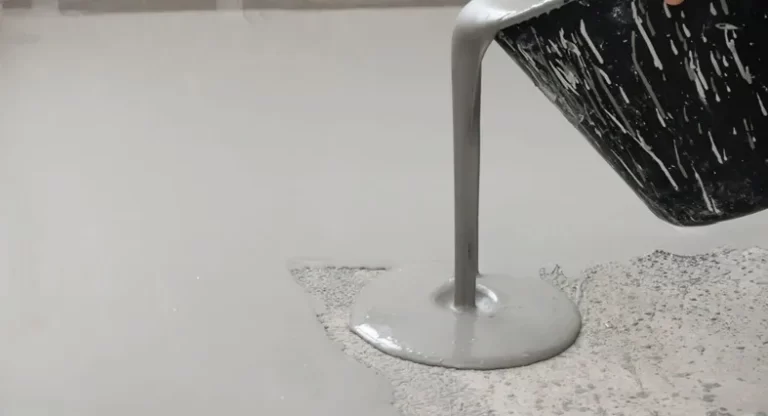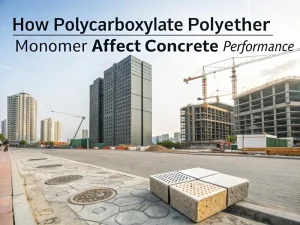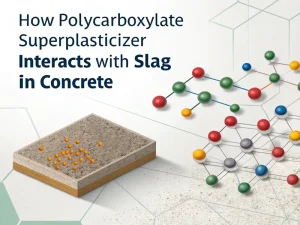Blog

Since its development in Japan in the 1980s, SCC has become a major product for high-rise buildings, precast concrete production, and infrastructure projects worldwide. Its increasing popularity stems from a series of advantages that address key pain points in traditional concrete construction, from labor costs to structural durability. In this article, we analyzed what self-compacting concrete is and its core advantages.
Self-compacting concrete (SCC) is a revolutionary building material. Unlike traditional concrete, traditional concrete requires mechanical compaction to remove bubbles and ensure complete coverage. The core feature of SCC is that it can flow and fill the formwork evenly only by its own gravity without any external vibration. It relies on precise balanced mixing of aggregates, cement, water, and chemical admixtures such as polycarboxylate ethers to achieve excellent workability and filling capacity.
Self-compacting concrete has three key characteristics:
1. High Flowability: Able to flow easily like a viscous liquid.
2. High Passing Ability: Able to smoothly pass through areas with dense steel reinforcement without being blocked.
3. High Segregation Resistance: During the flow process, stones, sand, and cement slurry can maintain uniform mixing without separation.
In any project, time and cost are the most important factors that managers are concerned about.
No need for vibration operation: This is the most direct cost savings. You no longer need to hire professional vibration workers or purchase and maintain vibration equipment.
Extremely fast pouring speed: SCC can be poured much faster than traditional concrete because it can quickly level and fill in place. For large floor slabs or walls, this can save hours or even days of construction time.
Reduce subsequent repair work: Due to the ability of SCC to form a smooth and even surface (which we will elaborate on in Advantage 5), the polishing, repair work, and related costs caused by surface defects in the later stage are greatly reduced.
Overall, although the unit material cost of SCC may be slightly higher, its overall cost-effectiveness is often higher by saving time, manpower, and repair costs.
This is the fundamental advantage of self compacting concrete. The quality of traditional concrete largely depends on the vibration techniques of workers. Insufficient vibration can lead to honeycombs and holes; Excessive vibration can cause segregation and bleeding.
Eliminating human errors: SCC completely eliminates the vibration process, thereby eliminating quality defects caused by improper vibration.
More uniform and dense structure: Due to its self compacting properties, SCC can form a more uniform and dense internal structure, significantly reducing internal pores.
Improved strength and durability: Lower porosity means higher compressive strength, lower permeability (stronger resistance to water and chemical erosion), and better grip with steel bars. In the end, the building achieved a longer service life and higher safety.
Construction sites are high-risk environments, and traditional concrete compaction can help solve several safety issues. SCC minimizes these risks through the following methods:
Eliminate injuries related to vibration: Mechanical vibrators can cause high-level arm vibration syndrome (HAVS), a painful condition that can damage nerves and blood vessels in the hands and arms. Long term exposure may lead to permanent disability. By eliminating the need for vibrators, SCC completely eliminates this risk.
Reduce the risk of falling and crushing: Workers operating compaction equipment typically need to climb onto templates, lean against edges, or work in narrow spaces (such as between columns). The self flowing nature of SCC means that workers can pour concrete within a safe distance (e.g. using chutes or pumps) without entering high-risk areas. This reduces the chances of falling, crushing injuries, or being trapped in the template.
Reduce noise pollution: The noise level generated by the mechanical vibrator is 85-100 decibels (dB), exceeding OSHA’s safe exposure limit of 85 dB within 8 hours. The placement of SCC is almost silent (about 50-60dB), protecting workers’ hearing and reducing noise interference to nearby communities (crucial for urban or residential projects).
For architects, SCC is a powerful tool for achieving creative design.
Easy filling of complex templates: Whether it’s curved walls, slender columns, or irregular artistic components, SCC can penetrate like water, perfectly replicating every detail of the template.
Dealing with densely reinforced structures: In areas with abnormally dense steel reinforcement such as bridges, high-rise building core tubes, or seismic structures, traditional concrete vibrators cannot penetrate at all. SCC can easily flow through the steel jungle, ensuring structural integrity.
Creating a more aesthetically pleasing plain concrete: SCC provides unparalleled convenience for achieving a smooth and uniformly colored Architectural Concrete effect.
Traditional concrete typically requires a significant amount of post pouring work (such as grinding, repairing, or painting) to repair surface defects such as honeycombing, bubbles, or unevenness. SCC provides smooth and high-quality surface treatment, minimizing these costs to the greatest extent possible
Self polishing surface:The fluidity of SCC creates a dense, smooth surface without visible pores or tool marks. This eliminates the need for grinding or repairing, reducing labor costs by 25% -40% after construction. For exposed concrete structures such as museum walls and office halls, the surface treatment of SCC is usually good enough to be used without painting or coating.
Fewer cracks and defects: Insufficient compaction of traditional concrete can lead to microcracks, which will expand over time and require repair. The uniform density and low shrinkage rate of SCC can reduce crack formation by 60-70% and lower long-term maintenance costs. For example, a parking garage built using SCC may require crack sealing every 10 years, while a traditional concrete garage requires sealing every 5 years.
In summary, the advantages of self compacting concrete are comprehensive and decisive. It is not only an upgrade of materials, but also an optimization of the entire construction process.
From providing excellent and reliable engineering quality, to significantly reducing project duration and overall costs, to liberating architectural design and improving construction environment, SCC has demonstrated tremendous value in various key dimensions of modern architecture. As building demands become more complex and sustainability becomes non-negotiable, self compacting concrete will continue to be the material shaping future buildings and infrastructure.

How Polycarboxylate Polyether Monomer Affect Concrete Performance
Blog How Polycarboxylate

How Polycarboxylate Superplasticizer Interacts With Slag In Concrete
Blog How Polycarboxylate